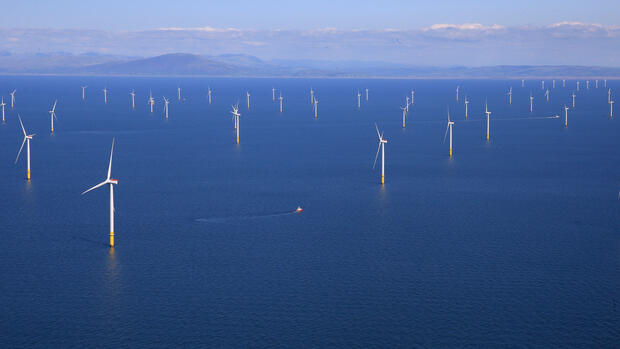Dusseldorf Far in the sea, north of the small island of Borkum, the Swedish energy company Vattenfall is building a wind farm at sea that will supply 1.7 million households with electricity. On Thursday, the company withdrew its right of entry for the area in the North Sea and confirmed the construction of the “Nordlicht II” wind farm, which is scheduled to go online from 2028.
The operators must acquire the rights to build a wind farm on the high seas in auctions. The lowest bids usually win. It is determined in advance how many cents a wind farm operator receives from the state for the kilowatt hour generated. However, the details are regulated differently in each country.
The difference lies in the system, says Jung. In Germany, people are not tied to a price, but are exposed to market prices, “and unlike in Great Britain, there is very strong demand for green electricity from industry.” The fact that the park in the North Sea is being built as planned is good news for the German wind power industry.
Internationally, several projects have surprisingly been put on hold in recent months. The Danish wind farm operator Orsted recently had to write off 730 million euros due to rising costs – and reserves the right to stop the projects in North America for the time being. Experts warn that even more projects could be on the brink.
The cost trap of the offshore industry
RWE boss Markus Krebber recently feared that ongoing inflation, rising interest rates, structural supply bottlenecks and strained supply chains could conjure up a “perfect storm” for offshore wind power.
Some operators have announced overly ambitious prices at auctions. At the end of last year, Vattenfall won the auction for the British wind farm with a bid of the equivalent of 43.55 euros per megawatt hour.
When it was planned to go into operation in 2026 or 2027, the energy company had expected to produce one megawatt hour of wind power for 43.55 euros. For comparison: According to Bloomberg New Energy Finance, the current production costs are currently just under 68 euros per megawatt hour. This is probably the main reason why the British project was stopped.
The “Nordlichter II” wind farm seems to be worth it for Vattenfall, otherwise the rights could have been forfeited. Vattenfall originally secured the rights to the North Sea project. However, after a legal change to the tender design, the cards were reshuffled. Everyone was allowed to bid on the space again. Competitor RWE won this auction last summer.
>> Also read: Industrial electricity prices could slow down the expansion of renewable energies
However, Vattenfall was granted a so-called right of entry – a kind of preferential right to build the wind farm for the price that RWE offered. It is unclear how high the Essen bidder was. The individual bids are not public. A total of four areas with a total output of 1,800 megawatts were auctioned for 784 million euros.
RWE has obviously calculated well – Vattenfall is now paying the amount and is thus exercising its right. However: The final investment decision is still pending.
Vattenfall is therefore not obliged to actually build the wind farm. This is exactly where Vattenfall manager Jung sees the mistake herself: “There has to be certainty earlier that the projects will come.” One possibility is to introduce higher fines for non-fulfillment.
In Great Britain, Vattenfall did not have to pay any penalties for his resignation. The two oil companies BP and Total, which recently won tenders for offshore land in Germany for a total of 12.6 billion euros, would only have to pay a fraction of that if they did not build the wind farms.
The final investment decisions are sometimes made a few years in advance. And then there remains a problem, says Vattenfall manager Jung: For projects, operators have to find different manufacturers for foundations, cables, turbines and other components. “And it’s not that easy right now,” she says.
Offshore wind capacities of 120 gigawatts (GW) are to be built in the North Sea by 2030. By 2050 it should even be 300 gigawatts. However, there is still a lack of capacity to achieve this goal. According to industry information, seven gigawatts can currently be installed annually. But 30 gigawatts are needed to achieve the goals.
More: Setback for the energy transition – offshore wind projects are stalling worldwide
